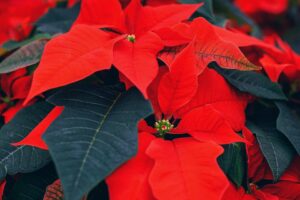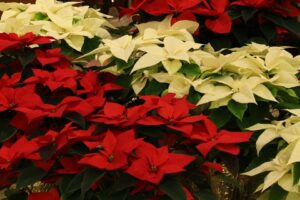How to Care for Poinsettias Indoors

A Plant that’s a favorite at Christmas time is poinsettias, these garden beauties have been a part of the Christmas tradition for centuries, in fact, history records that the tradition of poinsettias being used at Christmas time began ” in southern Mexico in the 1600s when Franciscan monks or priest used the colorful leaves and bracts to adorn extravagant nativity scenes”.
Poinsettias however are native to Mexico and Central America and belong to the Euphorbia family, their natural habitat includes rocky hillsides, and wooded ravines that are wet and moist, I have worked with poinsettias on many interior plantscape projects decorating hotel lobbies, office space, private homes, and many other public areas. These garden beauties provide various colors which range from red, green, pink, bright orange, purple, white, yellow, salmon, and many others colors. Of the many poinsettia colors my favorite is red, Below we will be taking a closer look at poinsettia growth and care.
Poinsettias Indoors Growth and Care
To keep your poinsettias growing healthy there are a few things you should know this knowledge will ensure that the growth and care of indoor poinsettias are easy.
Poinsettias Light Conditions: For poinsettias to thrive or grow healthy they must be placed in an area that gets bright indirect sunlight, direct sunlight will burn the leaves and the bracts. Place your poinsettias near a sunny window that meets this lighting requirement, 6-8 hours of indirect sunlight is ideal although this plant will survive with fewer hours of light.
Poinsettia Soil Type: If you must re-pot your poinsettias choose soil that’s loose or well-drained, a potting soil mixture that includes peat moss is ideal, the reason being although poinsettias need moisture too much moisture will encourage root rot. A loose well-drained soil will allow the drainage of excess moisture.
Poinsettia Watering Methods: Before watering your poinsettias check the first few top inches of the soil, if the soil feels dry when touched water the poinsettia thoroughly until water comes out of the container drain holes. If the poinsettias container is wrapped in a decorative foil remove the foil or poke holes in the foil to allow drained water to escape because if the poinsettia is allowed to sit in this water can lead to rot root.
Poinsettia Fertilizing Methods: Durning the poinsettia bloom period avoid fertilizing, fertilizing should start during spring, fertilize at half-strength when the plant slows down from growing. Some fertilizers to consider are 15-0-15, 20-10-20, or 15-16-17. Fertilizing can be carried out every 3-4 weeks until poinsettia is re-established.
Poinsettia Indoor Temperature: To keep poinsettias blooming and growing comfortably indoors provide a temperature of 65-75 degrees Fahrenheit during day time. Avoid cold drafts and keep the plant’s leaves from coming into contact with or touching the cold window.
Poinsettia Humidity Level: The humidity level plays an important part in the survival of indoor plants including poinsettias, if the indoor air is dry then consider investing in and humidifier that will keep the humidity level comfortable. A humidifier will increase the humidity level around your plants.

Additional information for Poinsettia Care
- A sure sign that you are overwatering your poinsettia is leaves that wilt, a lack of water can also cause wilting so check the soil first to make the right determination
- Lower leaves turning yellow can also be an indication of overwatering
- Leaf drop can be caused as well because of excessive water
- Blisters and small white spots may also be an indication of overwatering
- If the soil of your poinsettia is extremely dry then remove the plant from the decorative foil or from the tray or saucer and soak it in a tub or container of water for about 15-30 minutes this will ensure that your plant is getting adequate water. Next, remove the poinsettia and allow the water to drain from the pot or container holes, after 15 minutes return the poinsettia to the saucer or decorative foil
- If you discover that you have over-watered your poinsettia discontinue watering to allow the soil to dry before watering again or remove the plant from the container being very careful and change the soil to fresh healthy dry potting mix
Poinsettia Plant Facts
- Poinsettias are perennials
- Poinsettias need both sunshine and nighttime to bloom
- The showy colorful part of poinsettias are not flowers they are actually modified leaves or bracts
- Poinsettias can grow up to 15 feet
- Poinsettias have various colors
- There are more than 100 varieties of poinsettias
- In the US, the poinsettia is named after the Us Ambassador to Mexico, Joel Roberts Poinsett, who introduced the flower in 1825
- At Christmas, time poinsettias are the most popular and the most sold
- California is said to be the top producer of poinsettias
- Poinsettias are known not to be poisonous plants but despite this fact, the poinsettia plant should not be eaten which can cause stomach irritation and discomfort
- Poinsettias can be kept year after year
The final word on poinsettias grow and care
Growing poinsettias successfully indoors is possible, all it takes is knowing how to care for these garden beauties. You have come to the right place, just follow what we have discussed. Making poinsettias a part of your Christmas is a great way to celebrate this tradition as you connect with nature indoors. Give these garden beauties a try you will be so happy that you did as you bring a delightful transformation to your indoor living space.
About the author
Norman loves being in the garden, both at home and for his job....
he is 'Natures Little helper' being outdoors, growing his vegetables and flowers from an early age.
Now having spent over 22 years in the profession he want to give some of his knowledge to others...
his vast array of hints and tips you will find scattered over this site will help you no end growing plants in your garden.
